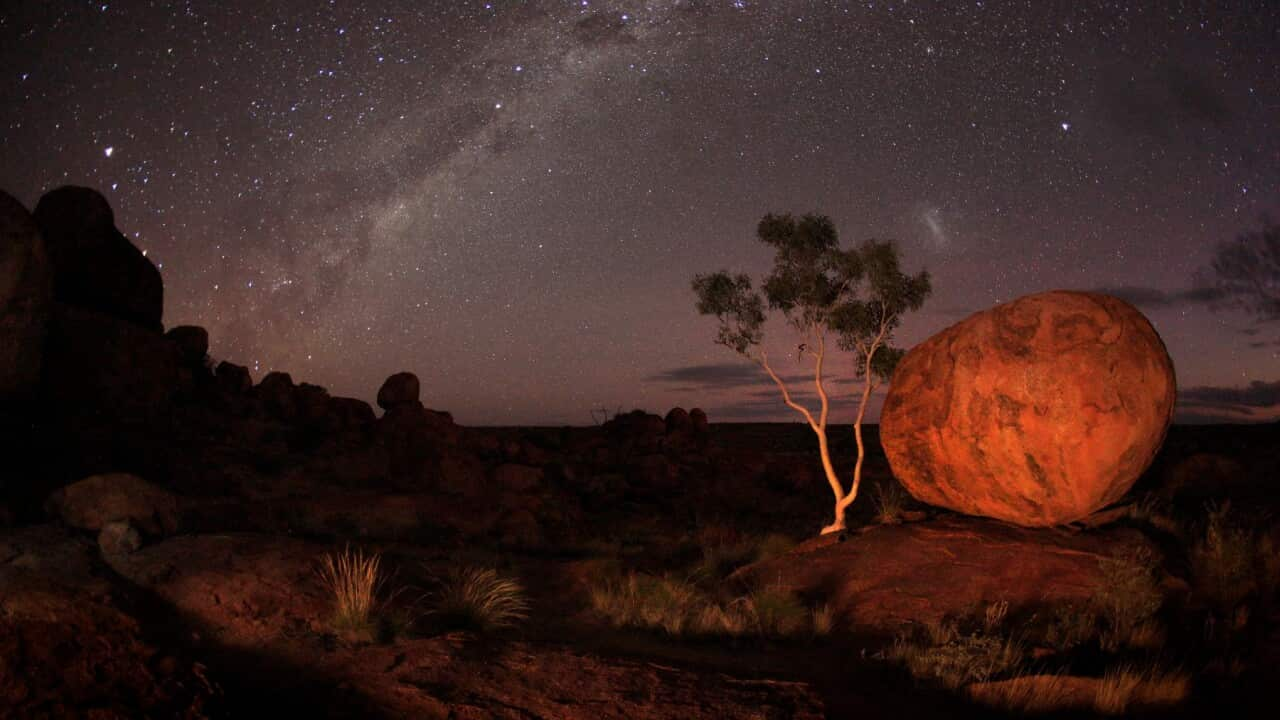Australia’s unique skies
In the Southern Hemisphere we see stars and constellations that are not visible from the Northern Hemisphere. We also benefit from many dark areas that are far from the sky glow created by bright city lights.
“When I moved to Australia from the US I was stricken by the beautiful skies and all the things you could see here that I couldn’t when I was up in the Northern Hemisphere,” says Duane Hamacher, Associate Professor of Cultural Astronomy at the University of Melbourne. “The plane of the Milky Way, the Magellanic Clouds, the Southern Cross – all of that was brand new to me, and it’s so clearly visible down here in the Southern Hemisphere.”
Australia’s famous Southern Cross is best viewed in autumn and winter in the south-eastern sky. It is made up of five stars that form a horizontal diamond and offer a great starting point from which to observe other phenomena. “The Magellanic Clouds look like two fuzzy clouds near the Southern Cross. But they’re not actually in our own galaxy. They’re two satellite galaxies to the Milky Way galaxy that we’re in, so you can only see them in the Southern Hemisphere,” says Carol Redford, founder of Astrotourism WA and known as ‘Galaxy Girl’.
“The Magellanic Clouds look like two fuzzy clouds near the Southern Cross. But they’re not actually in our own galaxy. They’re two satellite galaxies to the Milky Way galaxy that we’re in, so you can only see them in the Southern Hemisphere,” says Carol Redford, founder of Astrotourism WA and known as ‘Galaxy Girl’.

Southern Cross constellation Source: Getty images/Phil Clark/EyeEm
Far from the city glow
Galaxy Girl is growing dark sky tourism in regional WA where the expansive dark places present unrivalled stargazing opportunities.
She says, travel two or three hours from any Australian city and we find pristine dark night skies: beyond the Blue Mountains west of Sydney, in western QLD, in WA towards the east and even immediately outside of Perth.
The most amazing skies are seen from the desert, says Duane Hamacher.
The air is very dry, it’s very cool and there’s very little light. In August and September when the Milky Way is straight up overhead after sunset, it’s absolutely stunning.

Under the Milky Way Source: Getty Images/Supoj Buranaprapapong
The areas in between: Dark sky constellations
Both Western and Aboriginal and Torres Strait Islander views include different star groupings or constellations, says Duane Hamacher.
“But you also have some dark sky constellations that are unique to the Southern Hemisphere – constellations made not of the bright stars, but the dark spaces between the stars and the Milky Way. Those dark spaces in Western astronomy are areas of cool gas and dust. That’s where stars are being born.”
In the Aboriginal traditions, dark spaces trace out the silhouettes of animals, such as the Emu in the Sky.
Ghillar Michael Anderson is an Euahlayi Elder and astronomer from north-west NSW. He describes the emu as the protector of the water systems.
“Everybody has a relationship to that emu one way or the other. It lies in the Milky Way which means ‘big river in the sky’. That’s her physical incarnation up there, but her spirit also dwells here in the water.”

Emu in the Sky Source: Stellarium.org
The first astronomers
Without question First Nations people were Australia’s earliest astronomers, says Duane Hamacher. To navigate their way to Australia tens of thousands of years ago would have required astronomical knowledge.
“In those millennia they’ve developed very complex systems of knowledge around the stars. That’s what the Elders call ‘reading the stars’”, he says.
It’s said that everything on the land is reflected in the sky.
Weather events can be predicted by reading how fast the stars twinkle, and whether they change colour or appear sharp or fuzzy. The halos around the moon indicate that rain is coming.
The sky can also govern traditional social networks, says Ghillar.
“There’s a brightness on the east side of the Milky Way and that’s where the day comes from. And the west is where the night skies live. So you’ve got two different sections of that universe and the Milky Way that tell us what we can and can’t do.”

The sky above Spoonbill Lake, Chittering, one hour north of Perth Source: Astrotourism WA
Dark skies under threat
Light pollution is increasing by approximately 2% every year.
As our cities grow, more light is spilling up into the sky and obscuring the view of the stars. Galaxy Girl and Astrotourism WA are working in tandem with local governments to minimise light pollution.
“In WA we’ve got a big expanse of darkness, and the local governments have been integral to making sure that we can protect this beautiful asset.”
